Trading Day: ASX recovers, snaps 4-day losing streak
The ASX rebounded from a three-week low to snap a 4-day losing streak as Afterpay and Coles jumped after strong lifts in sales.
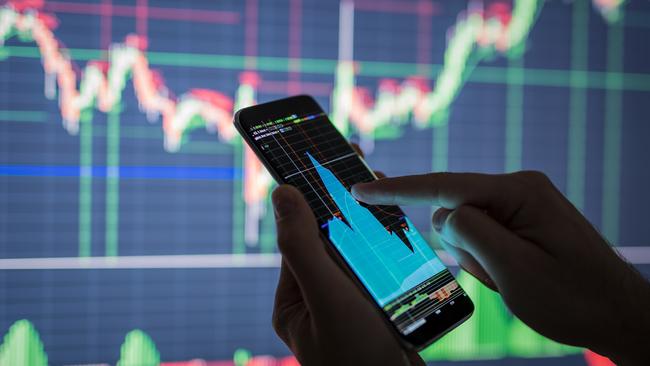
- Why Boral review disappointed
- Online stars for Super Retail
- HUB24 raising $60m for buys
- AMD buys chip rival Xilinx for $US35bn
That’s it from the Trading Day blog for Wednesday, October 28. Australian stocks recovered from a weak morning to enter positive territory despite further pressure on global markets. Afterpay and Coles posted sales updates and September quarter inflation data was released.
Joyce Moullakis 9.08pm: Industry super pulls $500m from Ellerston Capital
Ellerston Capital has suffered the loss of an industry fund investment mandate, understood to be valued at about $500m, on the back of the performance of one of the firm’s funds.
Sources told The Australian the mandate change was linked to the high-conviction Ellerston Australian Share Fund and its performance, although the industry fund remains a customer of Ellerston’s other funds.
According to Ellerston’s website, its Australian Share Fund manages about $2bn. It beat the performance of its benchmark over the three months to September 30, but has trailed the annual returns of the S&P/ASX 200 Accumulation Index over one, three and five years.
Robyn Ironside 7.30pm: Virgin finds regional solution with Alliance
Getting rid of ATR turboprops from its fleet was always going to pose a problem for Virgin Australia in terms of servicing regional centres.
With the capacity to seat 176 people, Boeing 737s are simply too big for routes such as Cloncurry-Mount Isa, Sydney-Tamworth and Sydney-Hervey Bay.
But the airline appears to have found a solution: by increasing its co-operation with Alliance Airlines on up to 40 regional routes and two short-haul international runs.
With a fleet of Fokker 50s, 70s and 100s, Alliance has the “right-sized” aircraft for the routes in question, which are likely to include Brisbane to Mount Isa, Cloncurry, Emerald, Rockhampton, Gladstone, Bundaberg and Port Macquarie.
Sydney to Albury, Tamworth and Port Macquarie may also be on the cards, along with Melbourne to Mildura, Newcastle and Kununurra and Cairns to Darwin and Maroochydore.
Prior to the COVID crisis that drove Virgin Australia into administration with debts of $7.1bn, Alliance was operating flights between Brisbane and Port Moresby for the larger carrier.
Under a new era of co-operation, that could be extended to Honiara in the Solomon Islands.
An application to the Australian Competition & Consumer Commission for greater co-operation between the two carriers noted that in order to service regional routes profitably airlines had to match aircraft type and capacity to the level and nature of demand.
The application also answered the question of “what’s in it for Alliance?”, pointing out the deal would provide the small operator with access to Virgin’s broader network, supply channels and association with its loyalty program. Submissions to the proposal are now being sought by the ACCC. The Australian understands Qantas will not object.
6.50pm: Revlon warns of bankruptcy restructuring risk
Revlon Inc. warned bondholders about the substantial risk of a bankruptcy restructuring if they don’t participate in a proposed debt exchange.
The New York-based company, which has struggled throughout the coronavirus pandemic, has been trying for months to swap out more than $340 million of bonds coming due in February at a discount to their face value. If Revlon can’t persuade bondholders to exchange those bonds, other lending facilities on which the company owes more than $1 billion could become due in mid-November.
Such a springing maturity on those credit lines would eclipse the roughly $347 million in liquidity that Revlon had as of earlier this month.
Revlon, majority-owned by billionaire Ronald Perelman’s MacAndrews & Forbes Inc., said Friday in a revised offering document that it would continue operating if it had to file for chapter 11 bankruptcy to restructure its balance sheet. Participation in the swap proposal has been slow, with deadlines for investors to take part extended several times already.
A Revlon spokesperson said the company’s main focus remains completing the exchange offer. The company said it is committed to protecting its liquidity, managing through the pandemic and ensuring that it has debt maturities that will give it time to turn around the business.
Dow Jones Newswires
6.29pm: Deutsche Bank expects strong Q4 investment bank revenue
Deutsche Bank expects its investment-bank arm to have another positive performance in the last three months of the year after its strong third quarter, and has a rosier outlook for the unit’s revenue this year.
“We expect investment bank revenues in the fourth quarter of the year to continue to perform well and consequently be significantly higher for the full year 2020 compared to the prior year,” the German bank said Wednesday.
Within the business, revenue at its key fixed-income and currency operations are seen “significantly higher” this year.
In both cases, Deutsche Bank had previously guided for higher revenue. In the third quarter, investment bank revenue rose 43%, with the fixed-income and currency business up 47%.
Dow Jones Newswires
Joyce Moullakis 4.55pm: Le Mesurier rejoins Velocity Trade
Former Shaw and Partners senior banking analyst Brett Le Mesurier is returning to Velocity Trade.
Sources said the banking and insurance research stalwart was rejoining Velocity Trade this week, after almost three years and Shaw and Partners. Le Mesurier parted ways with Shaw and Partners earlier this month.
His transition comes as ANZ readies to hand down its full-year profits on Thursday and Westpac, National Australia Bank and Macquarie Group report earnings next week.
Le Mesurier had a stint at Velocity Trade from mid-2016 to early 2018, according to LinkedIn. Prior to that he was managing director of research at Asia Pacific Prudential Securities.
Bridget Carter 4.50pm: Link rejects sweetened offer
DataRoom | Link Administration Holdings has rejected a sweetened takeover offer by The Carlyle Group and Pacific Equity Partners, but has allowed the private equity firms access to due diligence materials.
The due diligence access is on a non-exclusive basis.
4.44pm: Blackmores leads gains after upgrade
Blackmores’ offload of its Chinese medicine arm and upgrade from broker Credit Suisse has helped to propel the vitamin maker’s shares higher by almost 14 per cent on Wednesday, making it the best performing stock for the session.
Despite a lacklustre response to the sale of the Fusion Health and Oriental Botanicals brands yesterday, the upgrade to Neutral and $65 price target from Credit Suisse pushed shares to finish at a daily high of $72.48.
Elsewhere in the top 200, PolyNovo lifted 8.7pc, while Adbri took a 5.5 per cent hit to close at $2.90.
Here’s the biggest movers for the session:
4.25pm: ASX snaps losing streak
Australia’s sharemarket snapped a four-day losing streak with a slight rise despite further weakness in global markets.
After falling as much as 0.5pc to a fresh three-week low of 6020.2 in early trading, the S&P/ASX 200 index rose as much as 0.4pc to an intraday high of 6075.6.
But it finished at 6057.7 points, giving a marginal rise of 6.7 points or 0.1pc after shedding 15 points in the closing single price auction.
While up 4.2pc so far this month, the index was still down 1.8pc so far this week.
The local bourse dived 1.7pc on Tuesday after offshore markets were hit by jitters about the global outlook amid worsening coronavirus trends, US political uncertainty and delays in US fiscal stimulus. Global markets looked set to remain under pressure with S&P 500 futures down about 0.6pc in Asian trading.
Wednesday’s bounce was driven by the IT, Consumer Staples, Health Care and Consumer Discretionary sectors, with Afterpay up 7.3pc and Coles up 2.7pc on strong sales reports, CSL up 0.8pc and Wesfarmers up 0.7pc.
Energy, Financials and Real Estate sectors dragged, with Santos down 2pc as WTI futures fell 2.2pc in Asian trade, ANZ down 1.7pc as analysts pared dividend estimates after the $528m of writedowns flagged late Tuesday, Macquarie down 2.7pc before its results next week and GPT down 3.3pc as property trusts dived.
The Australian dollar was 0.22pc stronger against the US dollar by the close of the ASX session, trading around US71.45c
3.45pm: Risk outlook “remains heightened”: AOFM
Australian Office of Financial Management chief executive, Rob Nicoll, has given a sobering assessment of the risks that the AOFM faces as a bond issuer in potentially volatile global markets due to the coronavirus pandemic, global trade tensions and “major geopolitical risks”.
“The financial market outlook continues to be dominated by the potential for periods of extreme volatility,” Mr Nicoll said in the AOFM’s annual report.
Mr Nicoll warns that compared to the last few years, there is now “heightened uncertainty about the global outlook with no clearly defined path for a recovery out of the COVID-19 pandemic situation.”
“In addition, global trade tensions remain elevated as do a number of major geopolitical risks that could lead to the outbreak of regional conflicts,” he says.
“These, amongst other factors, remain relevant to the AOFM’s deliberations given how they could impact funding markets and investor preferences.”
Moreover, the risk outlook for issuance “remains heightened due to the potential for periods of extreme market volatility, and global funding markets will remain ‘crowded’ due to the large financing tasks many governments and businesses need to achieve.”
“Furthermore, the prospect - for a range of reasons - of AGS yield differentials dissipating could reduce the relative attractiveness of AGS to offshore investors.
Still, Mr Nicoll notes that much of the AOFM’s planning for risk events was tested and proved effective during the events of late February through until late April.
“While these were not events anyone would like to see repeated, they did provide a useful opportunity to test AOFM thinking on market access dynamics, including how funding markets recover from sharp and deep dislocations.
Managing liquidity risk is something that has already attracted close attention from the AOFM. This, together with maintaining enhanced monitoring of funding markets for signs of stress will remain key amongst our tasks in the year ahead.”
Adeshola Ore 3.42pm: Wine exports spike to decade high in value
Australian wine exports have hit their highest value in more than 10 years despite the uncertainty of Chinese tariffs hanging over the industry.
In the September quarter, wine exports surged by 23 per cent compared to last year to $860m.
Wine Australia’s latest export report valued Australia’s total wine exports at $2.99bn — a 4 per cent increase in the 12 months to September. The increase was driven by exports to the UK and China.
Wine Australia chief executive Andreas Clark said the overall value was at the highest since exports reached $3bn in the second half of 2007.
“Despite the unprecedented disruption that we’ve seen in markets around the world, Australian wine export volume has held reasonably steady and it is particularly pleasing to see both the overall value and the average value of exports growing during these challenging times.” he said.
In the 12 months to September, the average value of Australian wine exports increased by 4 per cent to $3.89 per litre. The volume of exports dipped 0.4 per cent to 771 million litres.
“During the July to September 2020 quarter, the value of exports increased by 23 per cent compared to the same period in 2019, and this comes after declines of 4 per cent in the April to June quarter and 7 per cent in the January to March quarter,” Mr Clark said.
3.09pm: Gray, Kingsmill join hipages board
Nicholas Gray and Inese Kingsmill will join the hipages board as non-executive directors.
Nicholas Gray, managing director of The Australian, NSW and prestige titles at News Corp, brings with him a wealth of experience in product development, sales and marketing, as well as ‘disrupting’ the marketplace through digital and online. He also holds board roles at UNSW Australia Foundation and SocietyOne.
Inese Kingsmill is set to deliver a range of expertise spanning sales, marketing, people and digital, having held previous senior roles with major technology organisations such as Microsoft and Telstra. Kingsmill is a co-founder of Breakfast Epiphanies Consulting & Advisory, and also currently holds Board roles at NobleOak, rhipe and Spirit Internet & IT.
Gray and Kingsmill join Stacey Brown, who has been a non-executive director at hipages since April 2019. Chris Knoblanche AM is chairman of the hipages board, having joined hipages earlier in the year.
DataRoom reported earlier this month that the float of hipages has been met with overwhelming demand — and now the company just needs to maintain its market share and earnings momentum ahead of its anticipated listing in November.
2.25pm: ASX in best 7-months of the year: Coppo
The Australian share market has come out of what has historically been the worst few weeks of the year and is now well into what has historically been the best and most profitable time of year to be in the market, according to Bell Potter.
In the 26 years since 1995, the local share market has a remarkable record of rising 24 years in the last 26 or 92 per cent of the time, says Bell Potter’s head of institutional sales and trading, Richard Coppleson.
The average seven-month gain in that period has been 5.88 per cent but if the two down years - the end of the bull market in 2007 and the GFC year of 2008 are removed, the average return over those 24 years was 7.7 per cent.
With the index currently up 4.3 per cent for the month to date, it would need to rise another 3.4 per cent to get back to the average of the 24 years when this period was positive.
Mr Coppleson says a repeat of this pattern is likely and potentially more than the average assuming effective coronavirus vaccines are available by then.
“Maybe we’ll have a move like we saw in 2012, when it rallied 18 per cent over this period,” he says.
The S&P/ASX 200 is up 0.3pc at an intraday high of 6071.8 after falling 0.5pc to a three-week low of 6020.20 intraday.
1.55pm: ASX up 0.2pc after 0.5pc fall
Australia’s share market is bouncing impressively off a three-week low.
After falling 0.5pc to 6020.20, the S&P/ASX 200 turned up 0.2pc to 6065.1.
This is the best intraday bounce since a 1.3pc rebound last Thursday.
It comes despite overnight falls and a 0.6pc fall in S&P 500 futures.
Volume is lacking but this bounce from the vicinity of former double top resistance and moving averages around 6000 is encouraging. The index is set to end a 4-day losing streak.
1.25pm: MQG down 2.9pc; worst day in 6 weeks
Macquarie Group’s share price is sharply underperforming before its results next Friday week.
Macquarie have fallen 2.9pc to a two-week low of $131.23 despite a bounce in the ASX200.
Bloomberg notes that Macquarie’s capital markets revenue may surprise positively after global peers reported strong trading gains across FICC, equities and commodities as well as underwriting revenue. But the consensus expects adjusted EPS to drop 39pc in fiscal 1H ended September - below management’s guidance for profit to fall 35pc - amid lower interest income, weaker asset management performance fees, delays in sale of assets, worsening credit provisions amid the pandemic and a stronger Australian dollar, which appreciated 16.8pc against the US dollar in 1H. Aircraft leasing and oil-and-gas lending exposure may weigh on outlook. But Macquarie’s solid capital position, with $8.1 billion in excess capital and a CET1 ratio of 13.2pc at end-June, should help it weather market challenges, Bloomberg says.
Macquarie is by far the biggest drag on the S&P/ASX 200 today.
Lilly Vitorovich 1.10pm: Isentia hit by ransomware attack
Media monitoring group Isentia says the cyber security incident reported to the ASX on Tuesday was a ransomware attack.
The group, which has more than 3000 clients in 11 markets, says its top priority is the restoration of services.
“It’s important that time is taken to do this in a safe and secure manner to prevent any recurrence. We have assembled a team of leading cyber-security experts, to assist us with working through the restoration and investigation process as fast as possible,” Isentia told The Australian.
Isentia has been tight-lipped on whether the attack has compromised its clients.
James Glynn 12.54pm: RBA ‘not lacking in firepower’
The Reserve Bank of Australia has scope to ease monetary policy settings further if it wants, and any suggestion that its firepower has run out can be dismissed, Ian Harper, a member of the central bank’s policy-setting board, told the Wall Street Journal.
“There is certainly capacity for the Reserve Bank to do some more if the board judges that that is appropriate. This idea that the bank has run out of ammunition is false,” he said.
Mr Harper, who wasn’t speaking on behalf of the RBA, said that while it is true there is little scope to lower the official cash rate further from its current record low of 0.25pc and the option of negative interest rates remains extraordinarily unlikely, the RBA still has the option of quantitative easing.
“The bank can purchase more government securities at different points on the yield curve. It can do more to manage the yield curve than it has currently done,” said Mr. Harper, who is also dean of Melbourne Business School. “It can also make more noises and commitment to the outlook for interest rates.”
As a further weapon, the RBA has scope to ramp up buying of government bonds almost indefinitely, Mr Harper added.
The comments come ahead of the RBA’s monthly policy meeting on Tuesday, with markets betting big that Gov. Philip Lowe will announce a number of measures to further stimulate the economy, among them QE targeting lower five-year and 10-year government bond yields.
Dow Jones
Perry Williams 12.49pm: Woodside told to focus on Scarborough
Woodside Petroleum would have to write an equity cheque of $US1.1bn ($1.54bn) to fund its expansion of the Pluto LNG plant in Western Australia and should instead focus on processing Scarborough gas through the North West Shelf LNG plant, Citi says.
Woodside had planned to process gas from its remote Scarborough field to prop up a bigger Pluto development, dubbed Pluto-2, with gas from the long-delayed Browse field to fill the NW Shelf plant.
However, this year’s oil price crash forced Woodside to delay both Scarborough and Browse, with some investors now making the case for Scarborough gas to help fill NW Shelf given the looming available capacity.
“On a net present value basis, we find Woodside is slightly ahead by 22c a share if building Pluto-2. However, this is eroded if the company raise equity to build Pluto-2, which we expect. Scarborough project returns are also significantly more compelling if processed at NWS, which is increasingly important in a competitive LNG market,” Citi analyst James Byrne said.
BHP, Woodside’s partner in Scarborough, and NW Shelf owners would also benefit if it went down that route. BHP’s net NPV would be $1bn higher and each NW Shelf owner could earn $US312m more.
Citi estimates the Scarborough-NWS concept has a 16.4 per cent internal rate of return and a breakeven LNG price of $US5.5/mmBtu compared to Pluto-2 where Scarborough IRR is 13.2 per cent and the breakeven LNG price is $US6.6/mmBtu.
Still, Woodside will likely continue talking up the Pluto-2 option given it remains an economic option.
“Woodside can continue to progress Pluto-2 as a credible alternative to processing gas at NWS. This provides Woodside with negotiating leverage over the NWS JV for setting any tolls for Scarborough.”
Woodside last down 0.8 per cent to $17.86 at 12.40pm AEDT on Wednesday.
12.40pm: China banks tweak yuan pricing formula
Chinese banks have suspended the use of the counter-cyclical factor to determine the daily yuan fixing, signalling Beijing’s willingness to let the Chinese yuan depreciate.
The banks, who provide the yuan’s exchange rate to the country’s central bank, have recently dropped the counter-cyclical factor, China Foreign Exchange Trade System said.
The suspension of the counter-cyclical factor could help promote transparency and efficiency of the yuan’s daily fixing mechanism, it said.
The tool was introduced by the central bank in 2017 to ease yuan’s depreciation pressure.
The Chinese yuan has been appreciating in recent months as strong recovery of the domestic economy has induced capital inflow. Earlier this month, China’s central bank cut the reserve requirement ratio for banks, making it cheaper to conduct foreign exchange forwards.
Dow Jones Newswires
11.59am: ASX recovers to be flat at midday
Australia’s share market was flat at noon after a sharp intraday fall.
The S&P/ASX 200 recovered to 6050 after falling 0.5pc to a three-week low of 6020.2 after further falls in offshore markets and a 0.6pc fall in S&P 500 futures as worsening coronavirus trends in Europe and the US and delays in US fiscal stimulus threatened the global economic outlook.
It was restrained by falls in the Real Estate, Energy, Financials and Industrials sectors, with Scentre down 1.5pc, Woodside down 0.8pc, ANZ down 1.6pc, Macquarie down 2pc and Atlas Arteria off 3.9pc.
However, ANZ pared much of a 2.8pc fall sparked by reductions in dividend estimates after a $528m charge for customer refunds and software.
Afterpay made the strongest positive contribution, surging 7pc after its 1Q underlying sales rose 115pc to $4.1bn.
Blackmores jumped 9.8pc after Credit Suisse upgraded to Buy and Steadfast rose 6.2pc after increasing its full-year earnings guidance.
Coles rose 2.3pc on a 10.4pc rise in September quarter sales, ResMed rose 3.8pc as BofA upgraded and Polynov gained 4.8pc on a regulatory approval.
CPI inflation data were slightly higher than expected but still well below target.
If the ASX closes in the red, it will be the longest losing streak in eight months.
11.36am: CPI data exceed estimates
Australia’s third quarter CPI data have exceeded estimates for the headline and one of the underlying measures.
Headline CPI on quarter rose 0.7pc vs 0.6pc expected and 1.6pc vs 1.5pc expected on year.
Trimmed mean CPI on quarter rose 0.4pc vs 0.3pc expected and 1.2pc vs 1.1pc expected on year.
Weighted median met expectations of 0.3pc on quarter and 1.3pc on year.
The Australian dollar and bond yields are little changed.
Inflation is well below the RBA’s 2-3pc target band.
Moreover the data won’t dissuade the RBA from cutting rates and increasing its assets buying.
Eli Greenblat 1 1.33am: Online sales star for Super Retail
Super Retail Group, which owns retail chains Supercheap Auto, BCF, Rebel and Macpac, says its sales momentum has continued into the new fiscal 2021 year, especially online, as consumers buy leisure and sports gear.
However, protracted lockdowns and limits on travel did dent sales for its camping retailer Macpac, which suffered a fall in sales for the beginning of 2021.
Addressing the company’s annual general meeting, chief executive Anthony Heraghty said in the first 17 weeks of 2021, the group delivered both total sales growth and like-for-like sales growth of 25 per cent despite the impact of COVID-19 restrictions, including lockdowns in Melbourne and Auckland.
Super Retail also maintained strong momentum in digital channels, with online sales growth of 132 per cent, including click and collect sales growth of 123 per cent. Click and collect represents 44 per cent of year to date total online sales.
Mr Heraghty said year-to-date sales performance across the group’s four core brands includes Supercheap Auto total sales growth of 22 per cent and like-for-life sales growth of 21 per cent.
Rebel had grown total sales by 16 per cent, with like-for-like also up 16 per cent.
BCF experienced extremely strong growth year-to-date, with year-to- date total sales growth of 63 per cent, and like-for-like of 61 per cent.
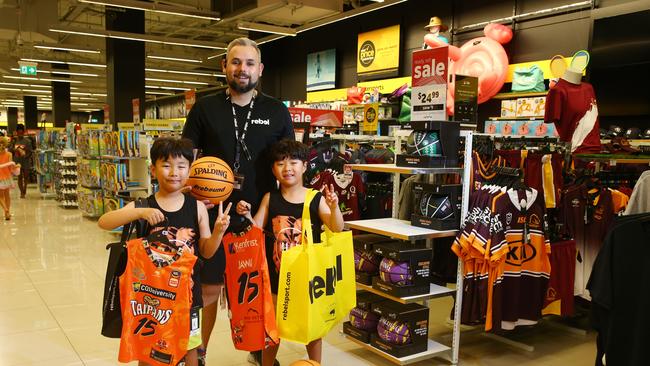
John Durie 11.27am: CHESS move delayed again
The ASX has again delayed the introduction of its CHESS replacement for another 12 months to April 2023 - some six years after formally approving the upgrade of its 25-year old equity settlement system.
The delay follows an extensive consultation process and will test whether concerns raised related more to governance issues rather than actual timing issues.
ASX boss Dominic Stevens said the delay was caused in part by COVID, with market participants worried about productivity challenges and also system capacity issues raised by the rapid increases in volume earlier this year when seven million trades happened one day; double the previous record.
Eli Greenblat 11.24am: Heineken buys Asahi assets
Global brewing giant Heineken has purchased a range of beer and cider assets from Japanese brewer Asahi as part of that company’s $16 billion acquisition last year of Carlton & United Breweries, marking the latest shakeup of beverage brands in Australia.
It also means that Coca-Cola Amatil, currently the target of a $9.3 billion takeover from Coca-Cola European Partners, will not be scooping up the Australian beverage brands, with some analysts predicting that its initial interest in the brands helped prompt the Coca-Cola European bottler to make its move.
The deal to sell the licences to Strongbow, Little Green and Bonamy’s, plus Stella Artois and Beck’s will help smooth the way for Asahi to take ownership of CUB, with the Australian Competition and Consumer Commission requiring the divestment of some of its local beer and cider brands to allow the acquisition to go ahead.
11.15am: Inflation data ahead
Australia’s official CPI data for the September quarter are due at 1130am.
Bloomberg’s consensus estimates for headline CPI are for a 0.6pc rise in the quarter and a 1.5pc rise in the year.
The trimmed mean is expected to rise 0.3pc in the quarter and 1.1pc in the year.
The weighted median is expected to rise 0.3pc and 1.3pc.
“CPI figures would normally dominate markets, but given the RBA’s explicit forward guidance, it is unlikely to be as market moving as previously,” says NAB’s director of economics and markets, Tapas Strickland.
11.13am: ASX on track for fifth day of falls
Australia’s share market is suffering its longest losing streak in eight months, having lost 2.6pc in the past five days.
Although paring most of its intraday fall to a 3-week low of 6020.2, the S&P/ASX 200 index was down 0.1pc at 6044 in late morning trade.
If it closes in the red today, the index will have fallen five days straight, its longest losing streak since an 11.3pc fall in the seven trading days to March 2.
It comes as global markets grapple with a resurgence of coronavirus in Europe and the US, as well as US political uncertainty and an extended delay in negotiating additional US fiscal stimulus.
It also comes after the S&P/ASX 200 hit a seven-month high of 6248.30 last week as the RBA indicated it will cut rates and expand its asset buying at next week’s meeting and after investors saw less risk for the domestic economy as coronavirus trends improved and the government delivered a highly stimulatory budget.
A seven-day winning streak to October 13 was the longest winning streak for Australian shares since mid 2009.
Perry Williams 11.09am: Why Boral review disappointed analysts
Boral’s review of its North American assets fell short of market expectations by failing to specify what would be sold, Morgan Stanley said.
Boral said on Tuesday it will consider offloading its US building products business after receiving interest from suitors but may also retain the division depending on performance.
“The review failed to deliver a decisive or definitive list of non-core assets - we believe the market was looking for confirmation of widespread US exits. Instead, management will look to improve operations, with a view to testing the market for certain (undisclosed) assets in CY21,” Morgan Stanley analyst Andrew Scott said.
Still, management may get the benefit of the doubt after surpassing expectations with the $1.43bn sale of its USG Boral stake.
“While we think this did fall short of what the market was hoping for, we believe that the good outcome on the JV earns management the benefit of the doubt. We expect material asset rationalisation will ultimately occur,” Mr Scott said.
Boral could bank $1.5bn to $2bn for its US building products unit if it does proceed with a sale, Citi analysts said.
The USG Boral deal still faces risks for Knauf which is buying the half share from Boral, Goldman Sachs noted.
“One key impediment to the transaction remains the possible divestment of Knauf’s existing Australian assets, given competition concerns in the Australian plasterboard market - Knauf’s call option on USG-Boral Australia was previously rejected by the ACCC, and the market remains largely concentrated between Knauf, CSR and USG-Boral,” Goldman analyst David Schwartz said. Boral’s US fly-ash business will likely be retained, Goldman noted.
The USG Boral deal, allowing Boral to pay down debt, will start a balance sheet remediation process according to Jefferies.
“The resultant commentary about future capital returns must have seemed alien to those worrying about a capital raising just a few months ago,” Jefferies analyst Simon Thackray said. “A ‘leaner and more nimble’ Australian organisation and the identification of new property opportunities from sites previously viewed as essential leads to an expectation of a much more detailed operational review to follow.”
Boral was down 2.95 per cent to $4.60 at 11am (AEDT) on Wednesday.
10.27am: Banks lead as ASX dips at open
Australia’s share market fell more than expected in early trading as a sharp fall in US futures added to offshore weakness.
The S&P/ASX 200 was down 0.4pc at 6027 after falling 0.5pc to a 3-week low of 6020.2, as S&P 500 futures fell 0.6pc after the US benchmark fell 0.3pc overnight.
Banks did much of the damage as ANZ fell 2.6pc after announcing a $528m of provisions for its results on Thursday and the other major banks lost at least 1.3pc.
Apart from Financials, the Real Estate, Energy and Industrials sectors were also underperforming, with Scentre down 2.7pc, Ampol down 2.6pc and Qantas down 1.8pc.
On the positive side, Afterpay rose 3.2pc and Coles rose 2.4pc on strong 1Q sales updates.
Steadfast surged 6.4pc after upgrading its FY21 profit guidance, PolyNovo rose 4.4pc on regulatory approval in Taiwan and ResMed rose 3.8pc after BofA upgraded its rating.
Lachlan Moffet Gray 10.20am: Vocus set to meet forecasts
Telecommunications provider Vocus is on track to hit guidance for FY21 and successfully pull off its three-year turnaround plan after the coronavirus pandemic increased demand for bandwidth.
Speaking at the company’s 2020 AGM on Wednesday, Vocus CEO Kevin Russell said he fully expected the company to hit an underlying FY21 EBITDA “in the range of $382-$397 million,” driven by growth in Vocus Network Services.
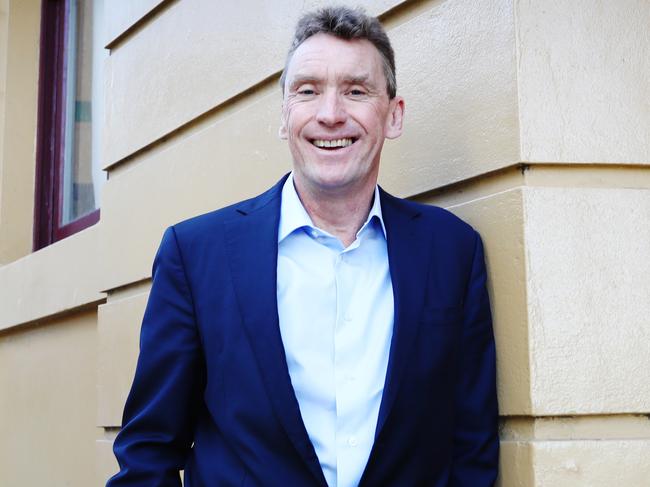
“We expect Vocus Network Services to deliver revenue growth of at least five per cent in FY21, which exceeds the three per cent growth in the key data and IP networks segment in the prior period,” Mr Russell said.
“And we expect VNS to deliver underlying EBITDA growth in the 8-12 per cent range, which we believe will be a market leading performance in this segment.”
Mr Russell also said capex would be reduced from $200m to $160-$180m and the group’s financial leverage will be reduced, on the back of growth as COVID-19 inspires an “acceleration of market trends.”
10.00am: ANZ’s dividend may disappoint: MS
With its 2H result weighed down by $528 million of charges, ANZ’s final dividend is in doubt, according to Morgan Stanley.
The broker had expected ANZ would absorb net charges of $158 million in 2H, and had forecast a final dividend of $0.45/share for a 2H payout ratio of 54pc.
“This means ANZ will need to beat our forecast for 2H profit excluding notable items in order to pay a $0.45/share final dividend and comply with APRA’s guidance that banks ‘seek to retain at least half their earnings,” the broker says.
Nick Evans 9.56am: Bid for Altura may be behind Pilbara halt
Pilbara Minerals has halted trading in its shares ahead of an announcement of a “potential acquisition”, believed to be a bid for collapsed lithium producer Altura Mining.
Altura’s lenders called in both receivers and voluntary administrators on Monday, triggering the collapse of the miner, a close neighbour of Pilbara Minerals.
US bondholders owed $250m by Altura took control of the collapsed company on Monday, pre-empting a $200m recapitalisation of the struggling miner.
Pilbara Minerals is believed to have been in discussions with Altura over the last month, along with fellow WA lithium producer Galaxy Resources, but no deal was done and Altura’s board is believed to have opted for the dilutionary raising in the absence of a firm deal for its assets.
Receivers KordaMentha said on Monday they believed a deal could be done to sell the company’s assets by the end of the year, as they prepared to mothball the company’s lithium mine.
The issue for Pilbara will be how it pays for any potential acquisition, with the company having recently having recapitalised its own lending facilities in August through a new $US110 million debt package from BNP Paribas and the Clean Energy Finance Corporation.
Altura had $2.3m in the bank at the end of June, plus another $5.7m of bank letters of credit for lithium shipments to be loaded in July, with the company having burned through $42.8m in the previous 12 months.
But Altura believed it had until October 31 to complete a recapitalisation, and the demand from its lenders came days ahead of the expiry of an agreement to waive payments and covenants on Altura’s estimated $250m worth of debt.
Instead its secured lenders - including Castlelake, CarVal, Nomura and Clearwater Capital - blindsided the company, appointing KordaMentha as receivers and Cor Cordis as voluntary administrators on Monday.
Altura’s board was caught by surprise by the move, believing a Canaccord Genuity-led raising worth about $200m that would largely have cleared the company’s debts was all-but locked in, awaiting only the sign-off from its lending group.
Pilbara Minerals shares last traded at 39c. The company is yet to release its September quarter production report, but had $86m at bank at the end of June.
9.54am: What’s impressing analysts?
TPG Telecom raised to Neutral: UBS
Shopping Centres Australasia raised to Outperform: Macquarie
Evolution raised to Neutral: Citi
Blackmores raised to Neutral: CS
Brickworks raised to Hold: Morningstar
PointsBet raised to Neutral: JPM
ResMed raised to Neutral: BofA
9.49am: Steadfast upgrades guidance
Insurance broker network Steadfast says it has upgraded its full-year guidance after an “excellent” first quarter.
It says underlying net profit guidance is up to between $120m and $127m, from $115m-$122m, while underlying EBITA is now forecast at between $245m and $255m, from $235m-$245m.
“Whilst there is uncertainty prevailing in the global economy, the trading conditions experienced in the last six months provide confidence as to the resilience of our insurance broking and underwriting agency businesses,” Steadfast said.
9.40am: Shares to stay under pressure
Australia’s share market faces further downward pressure from offshore weakness.
The S&P 500 fell 0.3pc and the Euro Stoxx 50 lost 1.1pc amid worsening coronavirus trends although US economic data mostly beat estimates.
Overnight futures relative to fair value suggest the S&P/ASX 200 will open down 0.3pc at 6033, which would set a new 3-week low.
Strong support should be located at the former double-bottom resistance at 6000.
The 50, 100 and 200 day moving averages also offer support at 6023, 6010 and 5976.
These moving averages crossed over last week, backing the uptrend for the first time since March. There’s also a potential uptrend line from the March low, at 5960.
The S&P 500 is currently holding above an equivalent uptrend line.
Investors will be digest ANZ’s $528m writedown released after the close
If peer reactions to similar writedowns in recent days are a guide, this may already be priced in. But the market might also be disappointed since a dividend may be off the table in its 2H results on Thursday. On the positive front, Afterpay shares should snapback after 1Q underlying sales rose 115pc to $4.1bn. And Coles has reported a 10.4pc in comparable store sales in the September quarter. September quarter CPI data are due at 1130am but have been eclipsed by the RBA’s explicit forward guidance.
9.20am: HUB24 raising $60m for aquisitions
HUB24 has announced three acquisitions and related capital raisings to strengthen its position in the financial platforms industry.
It’s buying Xplore Wealth via scheme of arrangement for $60m for a combination of cash and scrip, as well as Ord Minnett’s non-custody Portfolio Administration and Reporting Service for $10.5m cash, and a subscription of new shares in Easton Investment for $14m and divestment of HUB24 subsidy Paragem to Easton for $4m, which will leave HUB24 with a 40pc stake in Easton after a share buyback.
HUB24 is raising a total of $60m via a $50m institutional placement and $10m share purchase plan, and has a $12.5m debt facility with ANZ and will issue $30m of Xplore shares.
9.00am: HUB24 halted for M&A, raising
Hub24 shares have been placed in a trading halt pending an announcement on an equity capital raising and an acquisition.
Eli Greenblat 8.44am: Staying at home powers Coles sales
A strong consumer focus on home cooking and hygiene, especially in Victoria as the state limped through a protracted lockdown, has helped drive robust first quarter sales growth for Coles, with same store sales up 9.7 per cent.
Once again, online continued to be a key platform for sales as consumers were isolated at home or shunned large shopping centres, helping Coles’ online growth for the first quarter of fiscal 2021 to rise 57 per cent.
Releasing its first quarter performance, Coles revealed the strength of demand for core groceries, especially trolley items to help clean the home and for home cooking.
Coles said total revenue for the first quarter of 2021 rose 10.5 per cent to $9.6 billion. Liquor comparable sales growth was 17.8 per cent to 852 million and online sales growth of 80 per cent. Express convenience comparable sales growth of 10.2 per cent to $291 million.
Coles said total revenue for the first quarter of 2021 rose 10.5 per cent to $9.6 billion. Liquor comparable sales growth was 17.8 per cent to 852 million and Coles reported online sales growth of 80 per cent. Express convenience comparable sales growth of 10.2 per cent to $291 million.
In the first quarter, supermarkets’ comparable sales growth was driven by Victoria, and to a lesser extent New South Wales, as stage 3 and subsequently stage 4 restrictions were introduced.
Coles said same store sales growth excluding Victoria was 7.7 per cent. Sales growth in other states was on average elevated, but tapered off in the latter part of the quarter. The pattern of bigger basket sizes continued across the country, more than offsetting lower transactions.
“As customers continued to focus on home cooking and hygiene, key growth categories included baking mixes, herbs and spices and flour, cleaning goods and dishwashing, all growing by around 30 per cent,” Coles said.
Conversely, categories most negatively impacted by COVID were infant formula, facial tissues and beauty, all experiencing double-digit declines.
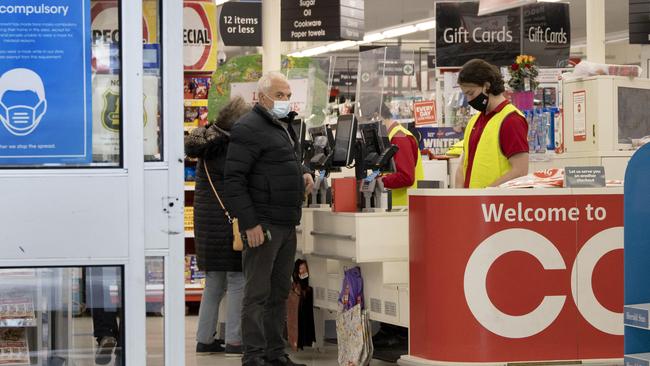
8.28am: Afterpay sales, customers soar
Afterpay first quarter underlying sales have increased 115 per cent to $4.1bn, after what it says was a strong performance across all regions.
The buy now, pay later company says the sales result was 9 per cent higher than the record underlying sales achieved in the fourth quarter of 2020.
Afterpay says momentum at the end of 2020 had continued into the first quarter, with the run rate for the first quarter at $16.4b, up from $15.0bn in the previous quarter.
Unaudited merchant revenue margins remained firm and continued to perform in line with 2020.
Active customers globally increased 98 per cent to 11.2 million, up from 5.7m in first quarter 2020.
Afterpay says 45 per cent of like-for-like sales growth in the quarter was driven by Millennials, with Gen X and Gen Z driving 25pc and 24pc respectively.
8.20am: Tech bosses to defend key internet law
Facebook Chief Executive Mark Zuckerberg, Twitter CEO Jack Dorsey, and Alphabet CEO Sundar Pichai will make their cases Wednesday to protect a crucial internet law that protects their social-media sites from being held liable for the content posted by their users. Zuckerberg, however, is open to change.
The trio of tech executives are scheduled to appear via videoconference before the Senate Commerce Committee and face a flurry of questions, especially from Republicans, on their handling of content. Republicans insist there is a bias against conservative values; Democrats counter that social media doesn’t go far enough to tamp down on hate speech and misinformation. Both parties agree something needs to be done about Section 230 of the Communications Decency Act.
“Section 230 made it possible for every major internet service to be built and ensured important values like free expression and openness were part of how platforms operate,” Facebook’s Zuckerberg is scheduled to say in written testimony, provided to MarketWatch. “Changing it is a significant decision. However, I believe Congress should update the law to make sure it’s working as intended.”
“The debate about Section 230 shows that people of all political persuasions are unhappy with the status quo,” Zuckerberg concludes.

Twitter’s Dorsey is taking a decidedly more stringent stand. “We should also be mindful that undermining Section 230 will result in far more removal of online speech and impose severe limitations on our collective ability to address harmful content and protect people online, “ he will say, according to remarks released by Twitter to MarketWatch.
Alphabet’s Pichai is expected to land somewhere in-between. In prepared remarks, he will warn lawmakers to “be very thoughtful about any changes to Section 230 and to be very aware of the consequences those changes might have on businesses and consumers,” according to testimony provided to MarketWatch.
“Of course, our ability to provide access to a wide range of information is only possible because of existing legal frameworks, like Section 230,” Pichai wrote.
Dow Jones
7.38am: Pandemic buoys Microsoft’s earnings
Microsoft posted another quarter of strong earnings fuelled by pandemic-era demand for cloud-computing services and videogaming.
The software company said sales rose 12 per cent to $US37.2 billion, generating a net profit of $US13.9 billion in the first quarter of its fiscal year. The results surpassed Wall Street expectations on revenue and profit for the quarter ending in September.
Revenue from Azure, the company’s massive cloud-computing service that has underpinned its financial success in recent years, increased 48pc from the year-ago period. Sales from Commercial Cloud, a broader metric of its cloud business, reached $US15.2 billion, compared with $US11.6 billion in the year-ago quarter.
“Demand for our cloud offerings drove a strong start to the fiscal year, “ Microsoft Chief Financial Officer Amy Hood said.
Microsoft’s personal computing business -- which includes licensing revenue from PC sales, the Xbox gaming platform and Surface laptops -- saw sales advance 6pc to $US11.8 billion. The gaming content business saw a 30pc jump in sales over the previous year. The business is also expected to get a boost later this year with the release of the new Xbox Series X gaming console.
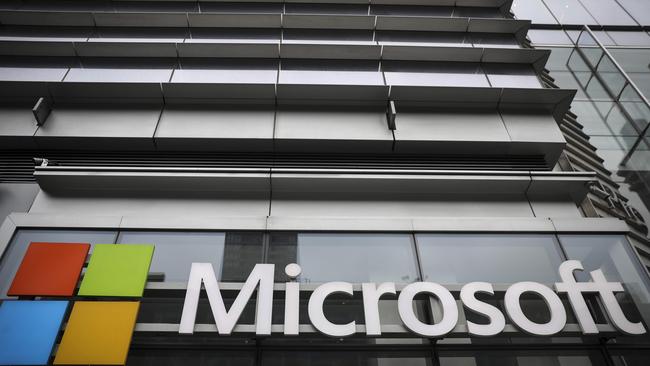
Dow Jones Newswires
7.10am: ASX to open lower
Australians stocks are poised to slip at the open as global markets tried to stabilise after yesterday’s tumbles.
At about 7m, the SPI futures index was down 24 points, or about 0.4 per cent.
On Tuesday, Australian stocks fell to a three-week low.
The Australian dollar was this morning higher at US71.34.
Brent oil is 1.8 per cent higher at $US41.20 a barrel on global supply concerns, while spot iron ore is up 0.6 per cent to $US115.70 a tonne.
7.05am: Wall Street ends mixed
US stocks wobbled after worries about the coronavirus pandemic sent markets tumbling to start the week.
The Dow Jones Industrial Average fell 0.8 per cent. The S&P 500 wavered for most of the day but finished 0.3 per cent lower, and the Nasdaq Composite advanced 0.6 per cent.
Rising COVID-19 infection levels around the world are compounding worries about the global economic outlook. The seven-day average of new cases in the US reached a record Monday, while a number of countries in Europe, including Italy, Spain and Russia, tightened restrictions on activity to try to curb the spread of the virus.
One factor that has helped stocks bounce back from selloffs in the past: evidence that parts of the economy have started to recover from disruptions and shutdowns related to the pandemic.
Orders for long-lasting factory goods increased for the fifth consecutive month in September, Commerce Department data showed Tuesday. Orders rose 1.9 per cent in September from August.
Craig Fehr, an investment strategist at Edward Jones, said despite uncertainty due to the rise in Covid-19 infections he remains positive about the market’s recovery heading into next year. “I think there are still more gains that can be seen in 2021. We’re probably likely to see the stock market produce both volatility and returns that are a bit more consistent with historical norms,” he said.
Some investors also are betting that authorities will avoid the stringent lockdown measures put in place in the spring, which brought the global economy to a jarring halt.
“At the moment, the market is discounting for further lockdowns and for the economy to suffer dramatically again, and I just don’t see that,” said Patrick Spencer, managing director at U.S. investment firm Baird. “We’re in a V-shaped recovery.”
Overseas, the Stoxx Europe 600 ticked down 0.9 per cent.
Dow Jones Newswires
6.37am: Mercedes-Benz to increase stake in Aston Martin
Mercedes-Benz maker Daimler announced it was stepping up its technical cooperation with Aston Martin that could see the German firm take a stake of up to 20 per cent in the James Bond carmaker.
The deal gives Aston Martin access to Mercedes-Benz’s next-generation hybrid and electric powertrains, as well as other vehicle components and systems.
Mercedes-Benz could see its stake in Aston Martin rise from 2.6 per cent currently up to 20 per cent, which corresponds to £286 million ($US374 million).
“Mercedes-Benz AG has no intention to increase its holding in Aston Martin beyond this level,” the automaker said in a statement.
Mercedes-Benz first provided technology for Aston-Martin in 2013, receiving a 5 percent stake which was reduced when the carmaker listed its shares in 2018.
Earlier this year Aston Martin recruited Tobias Moers, formerly the head of Mercedes-AMG, the performance division of the German car giant, as its new CEO.
AFP
6.35am: Stimulus after election: Trump
President Donald Trump said Republicans will approve a pandemic rescue package for the US economy after the November 3 election, seeming to concede defeat on efforts to reach a deal this week.
He also improbably predicted Republicans would regain control of the lower house of Congress, and blamed House Speaker Nancy Pelosi for the impasse in talks over steps to help counteract the devastating impact that the health crisis has had on households and businesses.
“She’s not interested in helping the people,” Trump told reporters at the White House.
“But after the election we will get the best stimulus package you’ve ever seen because I think we’re going to take back the House,” said Trump, who is trailing well behind former vice president Joe Biden in the polls.
After months of negotiations between Pelosi and Treasury Secretary Steven Mnuchin, and despite signs of recent progress, there appears to be no time left to get the deal approved before Trump and Biden go before voters next Tuesday.
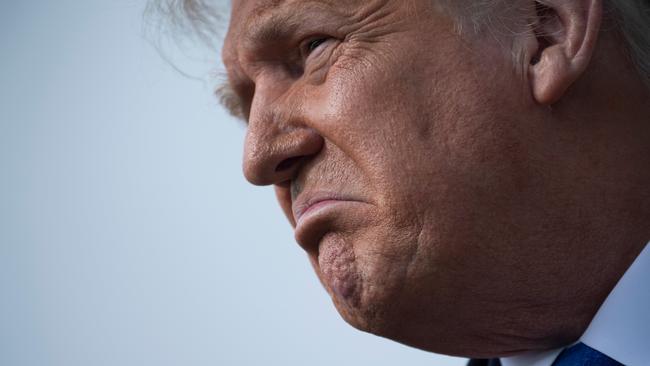
AFP
5.35am: US stocks waver after sell-off
US stocks wobbled, attempting to stabilise after worries about the coronavirus pandemic sent markets tumbling to start the week.
The Dow Jones Industrial Average fell 51 points, or 0.2 per cent, to 27634. The S&P 500 was up 0.2 per cent, and the Nasdaq Composite advanced 0.8 per cent.
Rising COVID-19 infection levels around the world are compounding worries about the global economic outlook. The seven-day average of new cases in the U.S. reached an all-time high Monday, while a number of countries in Europe, including Italy, Spain and Russia, tightened restrictions on activity to try to curb the spread of the virus.
One factor that has helped stocks bounce back from sell-offs in the past: evidence that parts of the economy have started to recover from disruptions and shutdowns related to the pandemic.
Orders for long-lasting factory goods increased for the fifth consecutive month in September, Commerce Department data showed. Orders rose 1.9 per cent in September from August.
Craig Fehr, an investment strategist at Edward Jones said despite uncertainty due to the rise in COVID-19 infections he remains positive about the market’s recovery heading into next year. “I think there are still more gains that can be seen in 2021. We’re probably likely to see the stock market produce both volatility and returns that are a bit more consistent with historical norms,” he said.
Some investors are also betting that authorities will avoid the stringent lockdown measures put in place in the spring, which brought the global economy to a jarring halt.
“At the moment, the market is discounting for further lockdowns and for the economy to suffer dramatically again, and I just don’t see that,” said Patrick Spencer, managing director at U.S. investment firm Baird. “We’re in a V-shaped recovery.”
Overseas, the Stoxx Europe 600 ticked down 1 per cent.
In Asia, most major equity benchmarks posted tepid declines. Hong Kong’s Hang Seng Index retreated 0.5 per cent and Japan’s Nikkei 225 was largely flat, while the Shanghai Composite Index ticked up 0.1 per cent.
Dow Jones Newswires
5.30am: Pfizer ‘could still deliver’ vaccine in 2020
Pfizer executives expressed measured optimism over the prospect of providing a coronavirus vaccine in 2020 as the pharma giant reported lower third-quarter profits due to disruption in healthcare that dented drug demand.
Pfizer Chief Executive Albert Bourla said the drug giant could supply some 40 million doses in the United States in 2020 if clinical testing proceeds as expected and regulators approve a vaccine.
“If all goes well, we will be ready to distribute an initial number of doses,” said Bourla, who pointed to a US government contract for Pfizer to supply 40 million doses by the end of this year and 100 million doses by March 2021.
But Bourla said the company still had not reached key benchmarks in assessing vaccine efficacy. Pfizer has said previously that it could have the data in October.
Bourla said the company expects to file for emergency use authorisation for its COVID-19 vaccine in the third week of November, roughly in line with earlier timetables.
Asked if he was “bullish” the vaccine would work, Bourla said: “I’m not bullish a vaccine will work. I’m cautiously optimistic that the vaccine will work.”
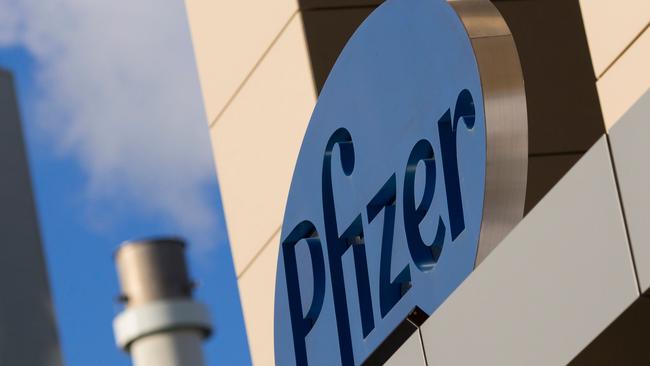
AFP
5.25am: HSBC reports third-quarter profit fall
HSBC said its third-quarter post-tax profits fell 46 per cent on-year as the Asia-focused banking giant continued to take a hammering from the coronavirus pandemic and spiralling China-US tensions.
However, the profit falls were not as bad as some analysts had predicted and HSBC said it expected credit losses to be at the lower end of a previously announced $US8 billion to $US13 billion range.
The global economic slowdown caused by the virus has hit financial giants hard and there is limited optimism on the horizon as Europe and the United States head into the winter with infections soaring once more.
HSBC has a further headache -- geopolitical tensions via its status as a major business conduit between China and the West.
As a result, the lender is in the midst of a worldwide overhaul, aiming to slash some 35,000 jobs by 2022, primarily in its less profitable European and American divisions.
“We are accelerating the transformation of the Group, moving our focus from interest-rate sensitive business lines towards fee-generating businesses, and further reducing our operating costs,” chief executive Noel Quinn said in a statement accompanying the results.
Reported post-tax profit for the third quarter came in at $US2 billion with revenue down 11 per cent at $US11.9 billion, the statement said.
Adjusted pre-tax profit slid 21 per cent to $US4.3 billion in the period, beating a $US2.8 billion estimate by Bloomberg analysts.
Quinn described the latest figures as “promising results against a backdrop of the continuing impacts of COVID-19 on the global economy” as well as low interest rates.
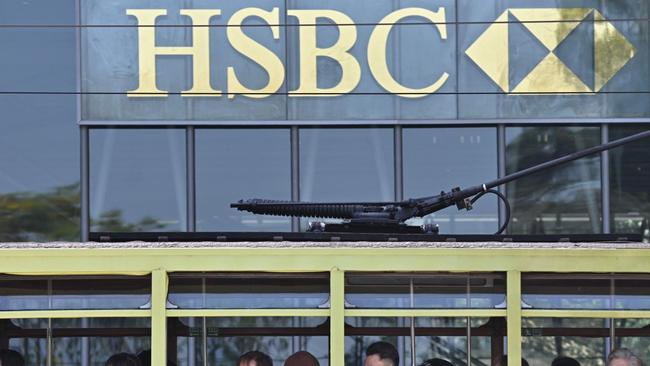
AFP
5.20am: Virus worries confine stocks
Stock markets failed to mount a rebound, after dropping sharply the day before on fears that a coronavirus resurgence will force fresh economically painful containment measures.
Traders have also given up almost any hope for a new US stimulus package being passed before next Tuesday’s election, with Democrats and Republicans blaming each other, though there are still expectations a new deal will be agreed afterwards.
The prospects of US lawmakers approving another round of stimulus has kept stock markets buoyant for weeks, but the US Senate wrapped up its session on Monday.
“This means that investor sentiment will be dominated by the resurgent coronavirus until at least the election day, as well company earnings,” said Fawad Razaqzada, a market analyst with ThinkMarkets.
On Wall Street, the Dow was down 0.3 per cent in midday trade, a day after it suffered its worst session since early September, dropping more than two per cent.
European stocks added to hefty losses on Monday as more nations move towards imposing tougher restrictions and even lockdowns in order to slow the spread of coronavirus but which would cause even more economic pain.
London ended the day down 1.1 per cent, while Frankfurt shed 0.9 per cent and Paris lost 1.8 per cent.
Asia’s leading indices closed mixed.
Oil prices rebounded after steep falls Monday, while the dollar dropped versus its main rivals.
AFP
5.20am: Airline revenues forecast to halve
Airline industry revenues are expected to remain 46 per cent lower in 2021 than the $US838 billion booked in the last pre-coronavirus year of 2019, industry body IATA said Tuesday in a marked worsening of its forecasts.
Its previous outlook for a smaller drop of 29 per cent “was based on expectations for a demand recovery commencing in the fourth quarter of 2020.” That is now unlikely to materialise because of renewed COVID-19 outbreaks and government restrictions in response, said the federation representing 290 airlines.
Over the full year in 2020, IATA forecasts a 66-percent drop in traffic compared to last year.
“The fourth quarter of 2020 will be extremely difficult and there is little indication the first half of 2021 will be significantly better, so long as borders remain closed and/or arrival quarantines remain in place,” IATA director general Alexandre de Juniac said in a statement.
Even with drastic cost-cutting, airlines will need further government aid to avoid running out of cash, de Juniac said.
AFP
5.17am: Nearly 200 European airports risk going bankrupt
Nearly 200 European airports risk insolvency in the coming months if passenger traffic does not recover, a trade association warned on Tuesday, as nations contemplate further lockdowns to combat a second wave of the coronavirus pandemic.
ACI Europe said the 193 airports facing insolvency are mainly regional airports which serve local communities.
But combined they support more than a quarter of a million jobs and 12 billion euros ($US15.6 billion) in gross domestic product.
“The threat of airport closure means Europe faces the prospect of the collapse of a significant part of its air transport system -- unless governments step up to provide the required support,” said the trade association.
A number of European nations have moved to provide specific help for airlines in addition to support measures offered to all companies hit by pandemic-related restrictions.
ACI Europe’s figures show airport passenger traffic was down 75 per cent in mid-October, which means airports -- like airlines -- have trouble covering operating costs.
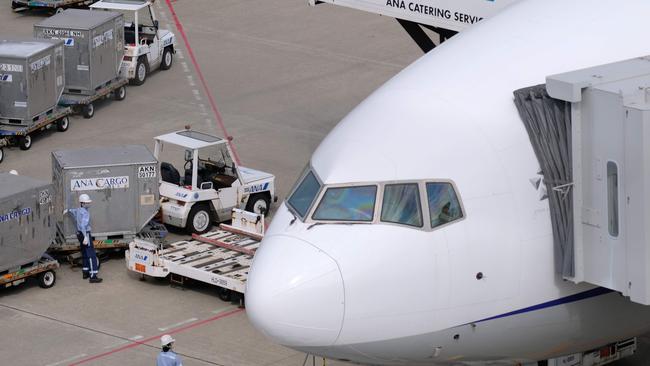
AFP
5.15am: ECB official urges ‘bad bank’
The European Central Bank’s supervisory chief on Tuesday urged the creation of EU-wide “bad bank” to ring-fence toxic loans that threaten to explode in the wake of the coronavirus pandemic.
In an opinion piece for the Financial Times, Andrea Enria said in a “severe but plausible scenario” that non-performing loans (NPLs) could reach 1.4 trillion euros ($US1.7 trillion), well above levels during the financial crash and eurozone debt crisis.
A build-up of NPLs, in which borrowers are unable to make repayments on time, can cripple the stability of commercial banks.
A “bad bank” is an institution set up to buy up bad loans, thus helping commercial banks improve their balance sheets. One was used successfully to help Spanish banks as part of a 40-billion-euro rescue package from the eurozone in 2012.
5.12am: US consumer confidence falls
US consumers were feeling less confident in October, a survey said on Tuesday, as rising coronavirus cases and a lack of economic stimulus clouded the forecast for the months ahead.
The Conference Board’s Confidence Index was at 100.9 this month, below expectations for it to increase further after it jumped to a downwardly revised 101.3 in September.
The survey found consumers’ perceptions of current business conditions improving, but the survey’s weakness came from a worsening outlook for the months ahead as the United States struggles with renewed COVID-19 outbreaks and Congress’s apparent failure to agree on new stimulus ahead of the November 3 presidential election.
AFP
5.10am: US durable goods up in September
Increased demand for cars and aircraft helped push US durable goods orders up by more than double what had been expected in September, Commerce Department data said on Tuesday.
The 1.9 per cent seasonally adjusted increase last month was an improvement from August’s downwardly revised growth of just 0.4 per cent, and came as manufacturers continue clawing back ground lost to the COVID-19 pandemic.
Transportation equipment made the biggest gains overall, rising 4.1 per cent to $US76.8 billion, an increase of $US3.0 billion.
Motor vehicle and parts orders climbed 1.5 per cent, while non-defence aircraft and parts orders reversed months of losses with growth of around $US1.8 billion.
Ian Shepherdson of Pantheon Macroeconomics said that increase came as Boeing received fewer order cancellations last month.
AFP
5.08am: AMD buys chip rival Xilinx
Advanced Micro Devices said it had finalised a deal to buy computer chip-making rival Xilinx in a transaction worth $US35 billion, further consolidating the industry.
“AMD today announced they have entered into a definitive agreement for AMD to acquire Xilinx in an all-stock transaction valued at $US35 billion,” the company said in a statement.
“The combination will create the industry’s leading high performance computing company, significantly expanding the breadth of AMD’s product portfolio and customer set across diverse growth markets where Xilinx is an established leader.” AMD is one of the largest semiconductor firms, specialising in processors for personal computers, servers and gaming.
AMD revenue has climbed this year, with the COVID-19 pandemic fuelling demand for computers and video game consoles as people rely on the internet to work, learn, and play more at home.
Xilinx, founded in 1984, is known for adaptive chip processing systems used in an array of industries including telecommunications, automotive and defence.
AFP
5.06am: Pfizer reports lower earnings
Pfizer reported lower third-quarter profits Tuesday as COVID-19 dented demand for some medicines from patients whose regular health care patterns were disrupted.
The drugmaker, which is working on clinical trials for a coronavirus vaccine, reported a 71 per cent drop in profit to $US2.2 billion. The year-ago period included a large gain connected to a transaction.
Revenues dipped four per cent to $US12.1 billion, missing analyst estimates.
AFP
5.04am: BP slashes losses as oil demand improves
British energy giant BP reported a net loss of $US450 million for the third quarter, down very sharply on the previous quarter’s mammoth losses due to the coronavirus pandemic.
The loss after tax for the July-September period compared with a net loss of $US16.85 billion in the second quarter.
BP was aided in the third quarter by an absence of huge writedowns coupled with a small recovery in oil demand and steadier prices.
“The underlying business performance in the (third) quarter remained resilient and we made substantial progress in strengthening our balance sheet,” BP chief financial officer Murray Auchincloss said in the earnings statement.
BP is axing 10,000 jobs, or 15 per cent of its global workforce, after the pandemic caused huge asset writedowns.
After companies worldwide closed their doors and airlines grounded planes at the height of the COVID-19 outbreak towards the end of the first quarter, oil prices dropped off a cliff, even briefly turning negative.
AFP

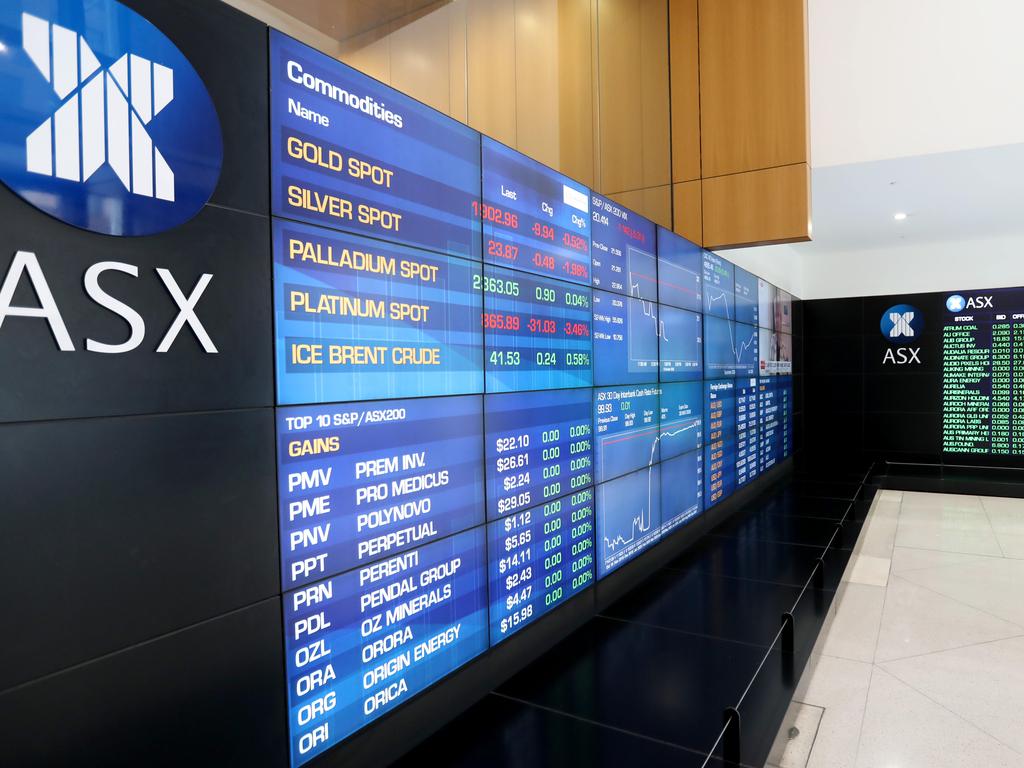


To join the conversation, please log in. Don't have an account? Register
Join the conversation, you are commenting as Logout